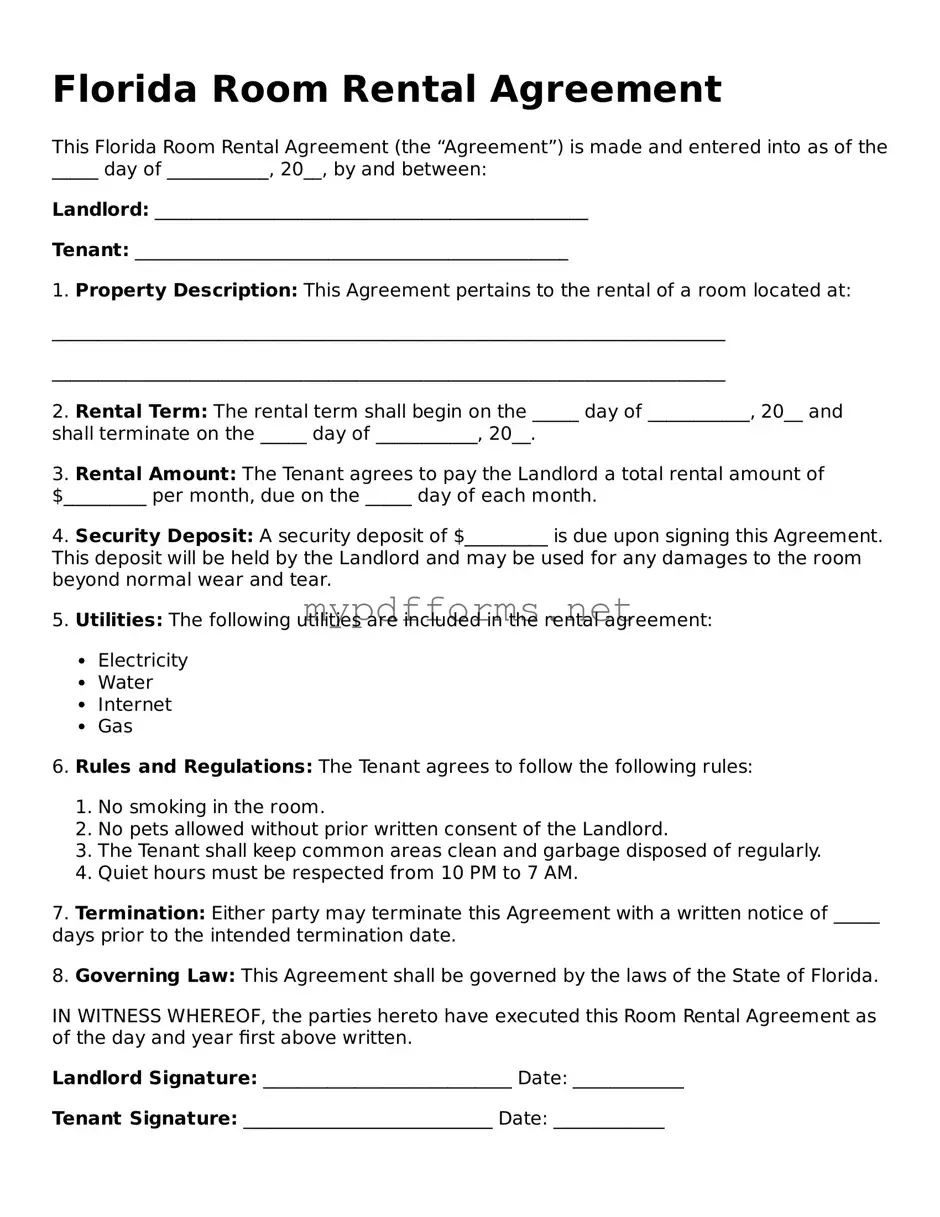The Florida Room Rental Agreement form shares similarities with a Lease Agreement, which is a more comprehensive document that outlines the terms of renting an entire property rather than just a room. Both agreements specify the duration of the rental, the amount of rent due, and the responsibilities of both the landlord and tenant. However, a Lease Agreement typically includes more detailed provisions regarding maintenance, utilities, and the rights of each party, reflecting the broader scope of renting an entire unit.
Another document that aligns closely with the Florida Room Rental Agreement is the Sublease Agreement. This form is used when a tenant decides to rent out a portion of their leased space to another individual. Like the Room Rental Agreement, it establishes the terms of occupancy, rent payments, and duration. However, a Sublease Agreement also requires the original tenant to remain responsible for the lease terms with the landlord, adding an extra layer of complexity to the arrangement.
The Roommate Agreement is yet another document that shares common ground with the Florida Room Rental Agreement. This informal agreement is often used among individuals sharing a living space, outlining expectations regarding rent, utilities, and shared responsibilities. While the Room Rental Agreement is more formal and legally binding, both documents serve to clarify the living arrangements and minimize potential disputes among roommates.
A Rental Application is also similar in that it is often used in conjunction with the Room Rental Agreement. This document collects essential information from potential tenants, such as employment history and references. While the Rental Application does not outline the terms of the rental itself, it plays a crucial role in the selection process, ensuring that landlords can make informed decisions before entering into a Room Rental Agreement.
The Rental Receipt is another document that complements the Florida Room Rental Agreement. Once a tenant makes a payment, the landlord provides a Rental Receipt as proof of payment. This document serves as a record for both parties, confirming that the agreed-upon rent has been paid. While it does not contain terms of the rental, it is essential for maintaining clear financial records.
Similarly, the Move-In Checklist is a useful document that parallels the Room Rental Agreement. This checklist is often completed before a tenant moves in and outlines the condition of the room and any furnishings. It helps prevent disputes regarding damages or maintenance issues when the tenant moves out, ensuring both parties agree on the state of the property at the beginning of the rental period.
The Eviction Notice is another document that, while more serious in nature, connects to the Room Rental Agreement. If a tenant fails to comply with the terms of the agreement, a landlord may issue an Eviction Notice to formally begin the process of removing the tenant from the property. Both documents are rooted in the legal relationship established through the Room Rental Agreement, highlighting the importance of adhering to its terms.
The Lease Termination Agreement also shares a relationship with the Florida Room Rental Agreement. This document is used when either party wishes to end the rental relationship before the agreed-upon term is completed. It outlines the conditions under which the agreement can be terminated and ensures that both parties understand their rights and obligations, much like the Room Rental Agreement does at the outset.
When considering the various agreements related to rental situations, it is also essential to recognize the role of a LoR, which can enhance an applicant's credibility by providing a personal endorsement from a credible source, ultimately supporting their application process in both rental and other opportunities.
Lastly, the Security Deposit Agreement is a document that complements the Room Rental Agreement by detailing the terms surrounding the security deposit. This agreement specifies the amount of the deposit, the conditions for its return, and any deductions that may occur for damages. Both documents work together to protect the interests of the landlord while providing tenants with clarity on their financial obligations.
